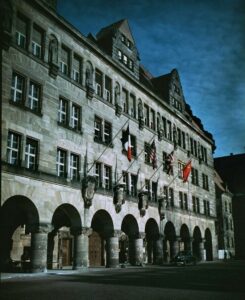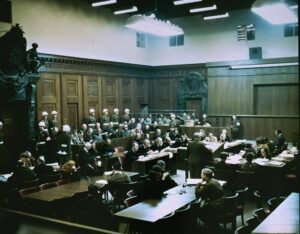On 20 November 1945 Soviet judge Major General Iona Nikitchenko opened the first session of the “International Military Tribunal” (IMT, a.k.a. the “Nuremberg Trial”) in the Palace of Justice in the German city of Nuremberg by the four main Allied powers – USA, UK, USSR and France – against the major German war criminals.
In total 24 high-ranking political and military leaders of Nazi Germany were indicted, as well as seven organisations (such as the SS) which would be deemed “criminal organisations” if found guilty. The defendants included former Air Secretary and commander of the Luftwaffe – and for a long time the number two in the Nazi hierarchy – Hermann Göring, minister for armaments Albert Speer, and editor/owner of the notorious Nazi paper Der Stürmer Julius Streicher. Martin Bormann, Hitler’s powerful deputy in the Nazi Party who could not be tracked down, was tried in absentia. The trial ended on 1 October 1946 with the reading of the verdicts. All but three defendants were found guilty; early conservative allies of Hitler, such as Franz von Papen or Hjalmar Schacht, were acquitted due to them not being found guilty of war crimes. Due to its charter, the IMT could only prosecute crimes committed during World War 2. Nazi crimes committed before 1 September 1939 were thus not included.

Legal History and Foundations
Early in the war it had already become known to Allied intelligence and politicians that Germany committed war crimes, particularly in East Central Europe. Polish underground army members had sent reports to London revealing the deportation and mass murder of Jewish people and others in the areas occupied by the Germans. The New York Times would report on the Holocaust – as it would later be known – on 26 October 1941 for the first time, whereas the London Times featured an article on the “Massacre of Jews” on 30 June 1942, reporting that up to this point approximately 1 million Jewish people had been killed by the Germans – a surprisingly accurate figure.
As the evidence of these crimes was growing during the war, especially when the Germans had to withdraw from their conquered territories but couldn’t destroy all the incriminating details, plans for a criminal trial against German leaders were drawn up by the Allies. The Soviets had already conducted a trial against three German officers and one Russian collaborator in December 1943 in the Ukrainian city of Kharkov for their role in the killing of Soviet civilians, many of them Jews being killed with mobile gas chambers. All four of them were sentenced to death.
In September of 1942, nine exiled governments residing in London had published the “Inter-Allied Resolution on German War Crimes”, setting out the course for prosecutions of German war criminals after the war. On 1 November 1943 the USA, UK and USSR at their meeting in Teheran published the “Declaration on German Atrocities in Occupied Europe” which made the prosecution of war criminals a war goal of the Allies. This was re-iterated at the Allied meetings at Yalta and Potsdam in 1945.
These declarations, however, were a political goal rather than a legal procedure. As a matter of fact, there was little to no precedence and experience of how to deal with state-sanctioned crime as was seen in World War 2 committed by the Germans. The Treaty of Versailles from 1919 between Germany and the victorious powers – the “Entente” – of World War One included articles on a war crime tribunal to be held against the German general staff for the war crimes committed in Belgium and France; around 900 Germans were asked to be delivered to this tribunal. However, both the German government and the Dutch government – the former German emperor Wilhelm II had gone into Dutch exile in November 1918 – refused to extradite any of the alleged war criminals; the leaders of the Entente powers eventually agreed to have the trial run by German judiciary at the supreme court in Leipzig, and reduced the number of alleged war criminals to 45. The trial in 1921, perhaps unsurprisingly, turned out to be rather farcical. Of the only twelve defendants that were put on trial between 23 May and 16 July, three received prison sentences of a few months for mistreatment of POWs, one defendant was sentenced to two years in prison for the summary execution of French POWs, another escaped prosecution for sinking a Canadian hospital ship by fleeing abroad, while the others were acquitted despite ample evidence for the murder of POWs.
Despite seen as a travesty at the time by international observers, the Leipzig Trial was significant, as it was the first attempt to define a system for prosecuting violations of international law. Furthermore, the failure of the Leipzig War Crimes Trial demonstrated to the Allies that these prosecutions cannot be left to the nation from where the alleged criminals hail. Hence, the idea of an International Military Tribunal was born; helped by the fact that Germany had unconditionally surrendered on 8 May 1945, and thus there wasn’t any German government left that could have interfered with Allied prosecutions. The “Instrument of Surrender” the Germans had signed had transferred all control over Germany to the Allies; the administration, the police and the judiciary were therefore under complete control of Britain, France, the USA and the USSR.

Hence, Allied legal scholars met in London on 8 August 1945 to draft the “London Charter” that would define the legal procedures and rules for the IMT. Given the different legal systems of the four powers, but also because of different political agendas in regard to Germany, this proved to be difficult, and explains why the twelve subsequent Nuremberg trials 1946—1948 against specific groups of perpetrators (such as the Einsatzgruppen) were carried out by the Americans alone. The other major issue was that there was no clear precedence for a trial of this kind. The Leipzig Trial of 1921 was seen as (bad) example, but due to it being conducted by the German judiciary, German military law had been used. The Nuremberg prosecutors now had to define a set of laws based on existing international agreements regulating the conduct in war, such as the Hague Conventions of 1899 and 1907. The IMT was thus based on four indictments: 1) Conspiracy for crimes against the peace, 2) Planning, initiating and waging wars of aggression, 3) Participating in war crimes, 4) Crimes against humanity. The latter being a novelty, as this for the first time offered a definition of genocide (although not by name): the murder and persecution of a civilian population based on racial, political or religious grounds. While the first three indictments could be derived from existing international law such as the Hague Conventions, indictment number four was a novelty. The driving force behind the stipulation of the four indictments was Soviet lawyer Aron Naumovich Trainin, who had already made a name for himself in the interwar years by attacking the League of Nations for not doing enough to prosecute those who wage war. Another important actor was Raphael Lemkin who had published on German war crimes in November 1944 for the first time and who had introduced the term “genocide” as part of this. Lemkin’s book influenced the London Charter of August 1945, and the American Chief of Counsel at Nuremberg, Robert Jackson, made the concept of genocide a part of his indictment for war crimes – although it would take a while longer for “genocide” to become a legal concept.

Legacy
The IMT was historically significant in more than one way. While it did not introduce the term and concept of “genocide” into law as such, it facilitated the notion of it through the inclusion of systematic murder of civilians because of race or religion in the indictments of “war crimes” and “crimes against humanity”. It provided the blueprint for the Tokyo Trials against Japanese war criminals 1946—48, also referred to as “International Military Tribunal for the Far East”. The Cold War would soon lead to individual trials by each occupying force, and to a rather selective prosecution according to political needs of either side. Likewise, after the creation of West and East Germany as sovereign states in 1949, the desire to prosecute those involved in crimes against humanity took a backset due to political interests and networks of former administrators and judges being back into office. Over time, however, the IMT became the reference point for prosecuting war criminals, such as the International Criminal Court established in 2002 at the Hague, which – among other things – prosecuted alleged war criminals from the 1990s war in Bosnia. The UNO Genocide Convention, and the Universal Declaration of Human Rights of 1948 were informed by the IMT proceedings. More importantly, in 1950 the United Nations’ International Law Commission would declare the seven “Nuremberg Principles” that would define what constitutes a war crime, and these have been the legal frame of reference since. Principle VI of the Nuremberg Principle included “Crimes against Humanity”, which describes genocide without using the term.
There were critics at the time of the IMT, predominantly Germans decrying the trial as “victors’ justice”. This accusation had some validity and was discussed among American legal scholars, but widely dismissed. The London Charter and the four indictments – particularly “crimes against humanity” – were seen as retroactive law (ex post facto). German defense lawyers at Nuremberg would argue exactly this: that at the time when the crimes were committed, no such law existed; consequently, while laws against murder can be used to prosecute the direct perpetrators individually, those politically responsible could not be tried summarily. The IMT rebutted this notion in its judgement, pointing to international treaties, such as the Hague Convention or the Covenant of the League of Nations, that Germany had signed and which included similar provisions to those made in the London Charter. There were also questions surrounding legitimacy and hypocrisy – the Soviet Union was part of the war of aggression against Poland in 1939 in cooperation with Germany, and committed a massacre against thousands of Polish officers at Katyn in 1940, but no Soviet officer or politician was ever tried for it. But this cannot distract from the fact that Germany had committed murder at an unprecedented scale, and that an orderly prosecution had successfully been carried out – despite the shortcoming of not prosecuting enough Nazi criminals. At least the IMT created a reference for international law against genocide and its prosecution.
Dr Alexander von Lünen is a Senior Lecturer in Digital Humanities at The University of Huddersfield.
09/11/21
